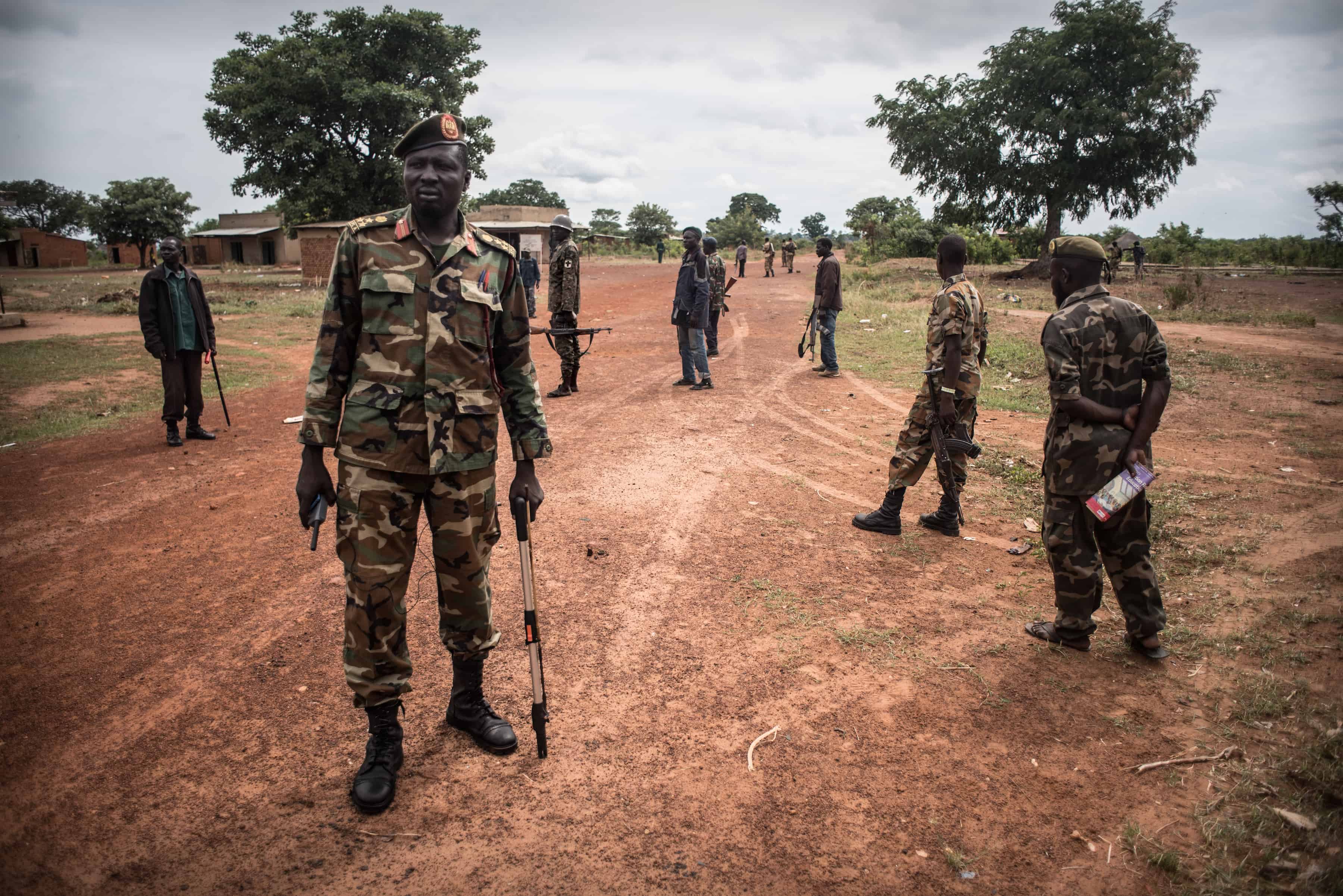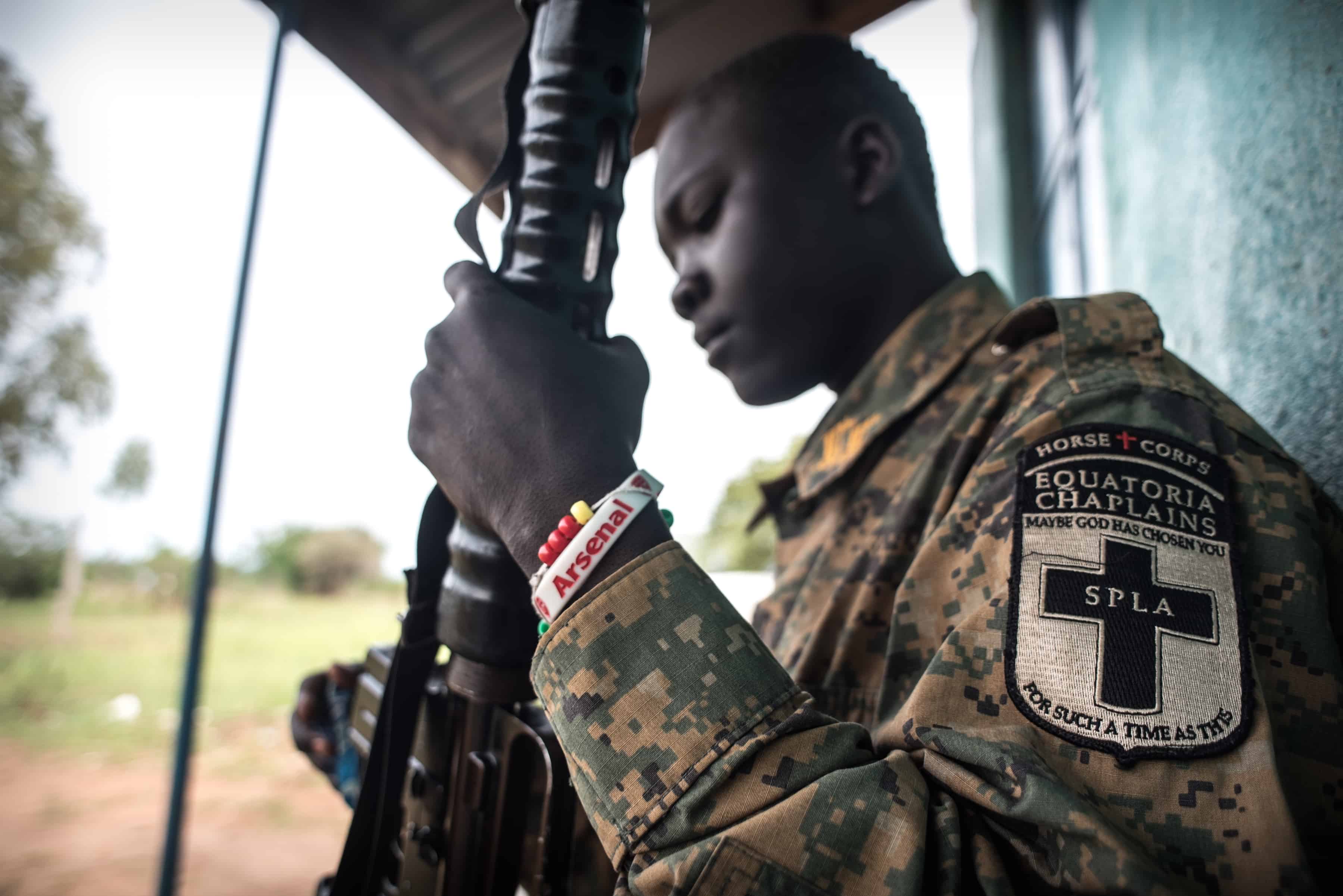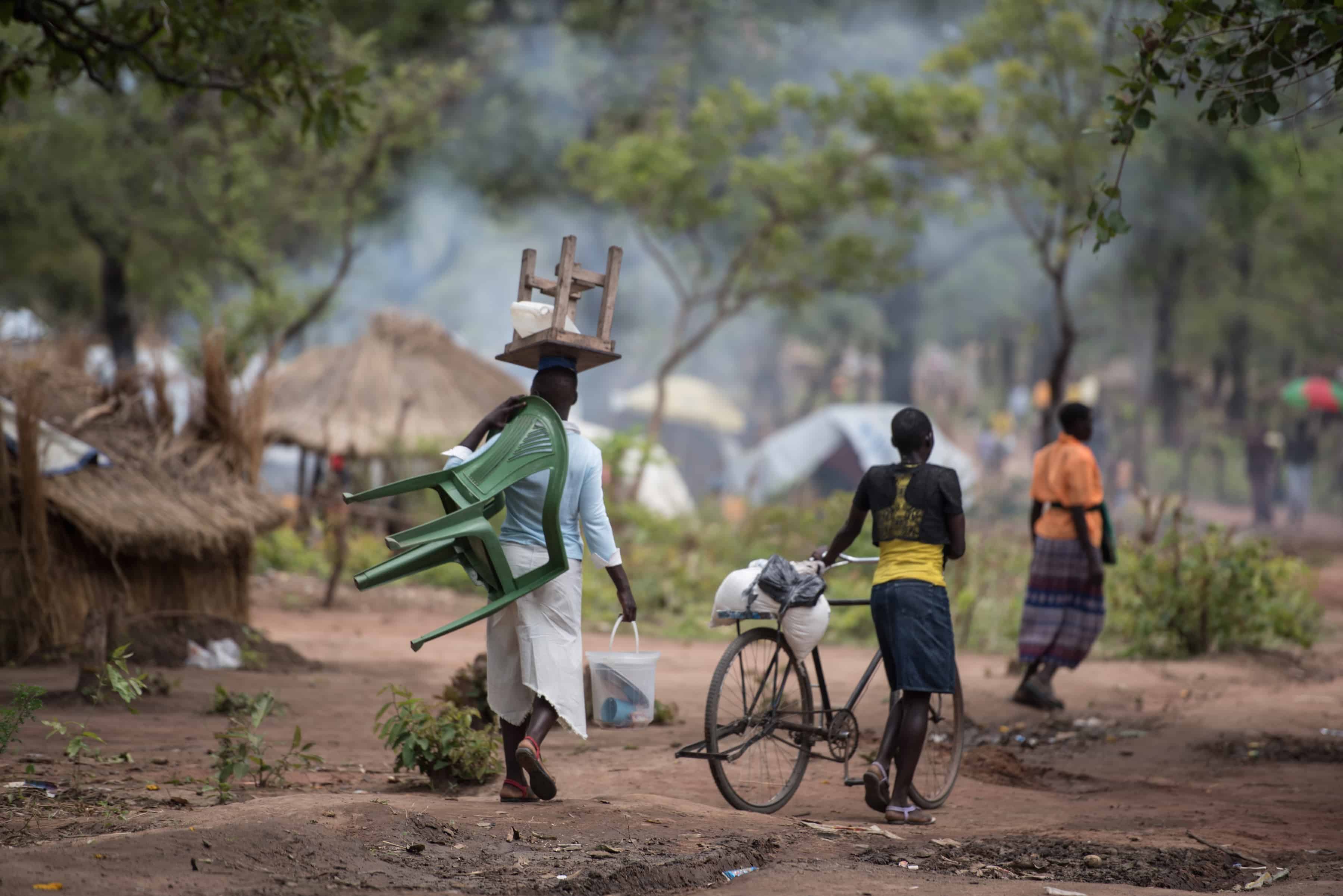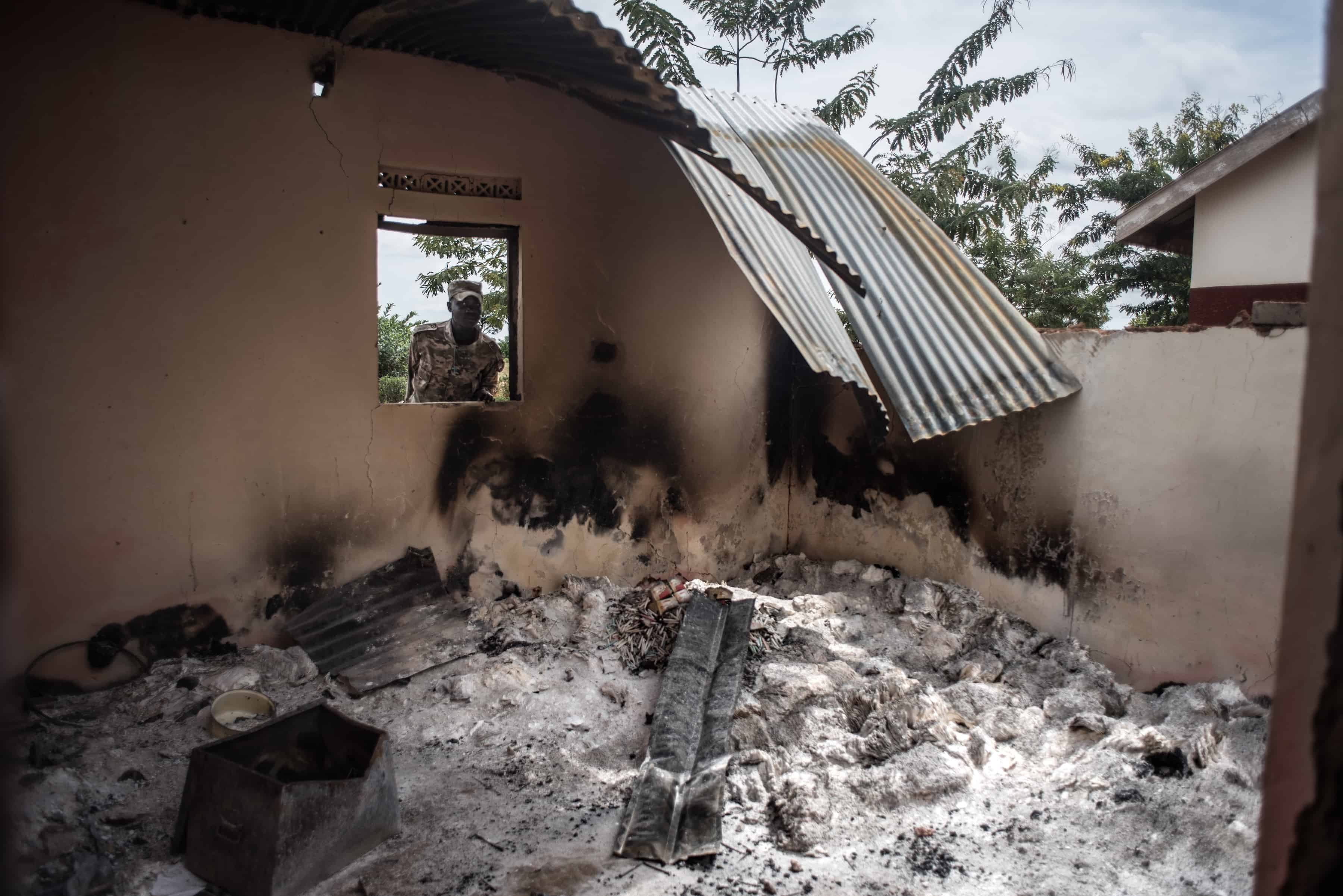Photos by Jason Patinkin
KAJO KEJI, South Sudan — Two Toyota pickup trucks filled with heavily armed rebels rattled down a bumpy dirt track. The convoy steadily advanced toward the front lines near Kajo Keji, a small town in the southern Equatoria region of South Sudan that has recently become a hotspot in the country’s civil war.
“Salva Kiir has looked for trouble this year,” the soldiers sang in call-and-reply, taunting the ruling president they’re seeking to oust. “This year it will be fire! Next year it will still be fire!”
The trucks came to a halt in Loopo, about two miles from the front line. The soldiers fanned out as Moses Lokujo, brigadier general in the rebel army, walked through the deserted village. Two weeks earlier, anticipating defeat, the rebels had retreated in what Lokujo described as “tactical withdrawal.” When they returned a week later, they found government forces had looted and destroyed Loopo’s primary school and torched most of its huts.
Across Equatoria, villages like Loopo are being swept up in violence as government and rebel forces vie for control, spelling destruction for once idyllic farming communities and signifying something deeper: Neither side is anywhere near securing a decisive military victory.

This is now the second war Lokujo, a 39-year-old ethnic Kuku from Kajo Keji, has fought on his home turf. At age 15, he joined the SPLM, the Sudan People’s Liberation Movement, then a rebel group that sought to liberate the marginalized south from Sudan and its longtime president, Omar al-Bashir.
After 22 years of fighting, Bashir’s government and the SPLM signed a peace deal in 2005, paving the way for South Sudan to become the world’s newest country in 2011; the SPLM was installed as the ruling party and Kiir was elected president. But another war broke out just two and a half years later, this time among the SPLM’s own ranks as its leaders wrestled for the country’s top post. When the army split into factions loyal to either Kiir or his former deputy, Riek Machar, Lokujo sided with Machar’s rebel movement, dubbed the SPLM-IO.
At that time, Equatorians like Lokujo didn’t play a central role in the conflict, which was confined to the northern Upper Nile region and drew in mostly Kiir’s Dinka and Machar’s Nuer tribe, the country’s two largest ethnic groups. But other tribes (South Sudan has no fewer than 64) shared grievances over the poor governance at the root of the crisis and began rising up against Kiir. Like Machar, Lokujo thought Kiir was running a tribalistic government that favored the president’s Dinka tribe.
As violence unfurled across Equatoria, it began to fall increasingly along ethnic lines. Government forces and a militia from the Dinka tribe, called the Mathiang Anyoor, were deployed to the region, targeting local tribes they accused of being part of the insurgency. In November last year, the United Nations warned the conflict could spiral into genocide.
The current war, like the one that preceded it, appears unwinnable. The country’s vast, thickly forested rural areas, with unpaved roads that make movement of heavy military equipment difficult to impossible, allow entrenched insurgencies to dig in their heels. Lokujo knows this all too well. He was based in Kajo Keji during the protracted independence struggle, when it was first a rebel stronghold. He believes that this time, too, a negotiated political settlement overseen by the international community will be needed to end the current fighting.
“The international bodies have to make sure there’s peace in South Sudan” he said. “If this war is not seen about, it will last [longer] than the one of Sudan.”
A botched peace deal
South Sudan’s conflict was supposed to be over by now. At least that was the aim of a peace deal brokered by IGAD, an eight-country regional bloc, and backed by the U.S., the U.K., Norway, China, the U.N., and the EU. Signed in 2015 by Kiir and Machar, the pact sought to end the civil war by reinstating Machar to his previous post as the young country’s first vice president, divvying up government positions between the signatories, and eventually reintegrating the rebels into the army.

But the agreement was short-lived. In July 2016, just three months after Machar returned to the capital of Juba, fighting again broke out in the city, accelerating the collapse of the agreement and forcing Machar’s people, who were outnumbered and outgunned, to flee the capital through the Equatorian bush.
Back in Juba, a small faction led by Taban Deng Gai, Machar’s chief negotiator, soon claimed the leadership of the SPLM-IO. Deng Gai was sworn in as first vice president, his faction replacing Machar’s in the 2015 peace deal. His rise to power was complete when then–U.S. Secretary of State John Kerry recognized him as the young country’s first vice president. Other international guarantors of the peace deal quickly fell in line and Machar, politically sidelined and suddenly unwelcome, fled to South Africa.
But the majority of Machar’s troops didn’t switch allegiance to Deng Gai as peace-brokers had expected. Machar’s rebels are on the back foot in what used to be the main theater of war further north, but they claim to be gaining ground in Equatoria, which has been the epicenter of violence for the past year.
Battling in the bush
The conflict in Equatoria bears the hallmarks of asymmetric warfare. The government has the greater firepower and controls the towns, while the terrain gives the rebels the edge in the bush. Areas of control shift through the ebb and flow of battle, with civilians paying the price.
Both sides have tried to misrepresent the facts on the ground in order to win support from the greater international community. In a June 1 letter to the U.N. Security Council, Deng Gai sought to discredit the presence of Machar’s people and further persuade the U.N., the African Union, and IGAD “to desist from engagement” with the rebel leader. He claimed that the government controlled “100 percent” of Equatoria and that the implementation of the peace deal was well underway.
The rebels, in an effort to justify their political relevance, purport to control everything outside Kajo Keji, but they frequently clash with government forces along the rural roads. A few days before our visit, Lokujo said government soldiers had snuck behind the front line in an attempt to attack the rebels’ flanks. “We knew they were coming,” he said. “So we waited for them.”
The rebels laid an ambush, the cornerstone of their guerrilla tactics and their only way to get weapons and supplies (the trucks that ferried us around for three days had been captured from the government a few weeks earlier).
The rebels have always been short of weapons in Equatoria, but over the last year the supply chain has all but dried up. Last year, neighboring Sudan stopped providing arms to the SPLM-IO, one of several conditions the country agreed to meet in exchange for badly needed sanctions relief from the U.S.
Now supplies and ammunition are in such short supply that wasting either can be met with harsh punishment. In our presence, Lokujo sentenced one of his men to 100 lashes because the soldier had drunkenly fired off his gun, squandering 13 bullets. “That could have been 13 enemy casualties,” Lokujo explained.
When his men go on an offensive, Lokujo said, up to half of them go armed with nothing but bows and arrows. “If you want a gun or bullets,” he said, “you have to get them from the enemy.” Because the government used public resources to pay for arms instead of development, Lokujo argued, the rebels had every right to “share” them.
Civilian aid — and casualties
Although the rebels are thoroughly outgunned, they’ve benefited from grassroots support and a steady flow of recruits. Locals join up in opposition to the government’s marginalization of Equatorian tribes and to fight the growing incursions of government-backed Dinka cattle-keepers into their land. More recently, they’ve been spurred by indiscriminate attacks on civilians.
Emmanuel Kenyi, a soft-spoken man in his 20s from the Mundari tribe, used to work for the government’s National Security Services, which alongside the armed forces makes up the government’s security apparatus. He joined the rebels in 2015, just a few months before the the peace agreement was signed.

Many Equatorians began aligning themselves with Machar during this time. They saw the peace deal, which returned Machar to office, as an opening to finally get their fair share of government and military patronage. Kenyi voiced frustration at the lack of opportunities for Equatorians, who he said were often relegated to lower ranks in the security forces.
“Since that government it built up in 2005 until now, we Equatorians got nothing,” he said. “That’s what made us come to the bush.”
Kenyi, who is now based in Kajo Keji under Lokujo’s command, was also disillusioned by what he saw as the wanton killing of civilians who didn’t belong to Kiir’s Dinka ethnic group. “Our civilians, they will just be killed,” he said. “Later, the information will come out that [it was] unknown gunmen when it’s the government soldiers killing them.”
In interviews with more than a dozen civilians who fled to Uganda or sought refuge behind rebel lines, there was no shortage of gut-wrenching accounts of what they characterized as government-led atrocities.
Agnes Kiden, a 35-year-old villager who used to lead a peaceful life with her husband growing cassava and maize, said she ducked out of her mud hut on a February morning to go to the bathroom when she heard gunshots. Hiding in the tall grass around her house, she said she watched eight government soldiers shoot her husband, her 3-year-old daughter, and several neighbors. Three of the soldiers, she says, then raped her sister-in-law before shooting her and burning the body.
Kiden blames the fighting in her area on the government, not the rebels. Like many others, she uses the term “Dinka” and “government soldiers” interchangeably, a worrying sign the war is being defined by ethnic polarization that could fuel violence and retaliatory attacks against entire communities.

The rebels also bear responsibility in the mounting civilian death toll, albeit on a lesser scale. They turn on those they perceive as sympathetic to the other side. Several members and leaders of the Kajo Keji community, for example, expressed shock at the rebels’ January execution of Oliver Jole, a local government official in Liwolo county. His killing was one of several clashes between the government and rebels that spiraled into broader violence against civilians, setting off a mass exodus to Uganda.
Seeking safety from government attacks, civilians have struck a quid-pro-quo arrangement with the SPLM-IO, which draws its soldiers from local tribes and is often described as a community protection force. It’s a symbiotic relationship: Civilians contribute food, and the rebels offer protection from the government militia. But the rebels lack the capacity to repel large government offensives, and as a result the relationship exposes civilians to collective punishment.
“After the government soldiers are defeated, they come and pay back the civilians — always,” said Bishop Emmanuel Murye, who buried five civilians in Mondikolok after they were killed in one such government assault in January.
A confused international response
The spread of conflict to Equatoria has compounded the humanitarian crisis in South Sudan and precipitated its spillover to neighboring countries. Today, Uganda hosts almost 1 million South Sudanese refugees, but donor funding is nowhere near enough to meet their needs. Tensions over resources between host communities and refugees are on the rise and could escalate, as could ethnic skirmishes between South Sudanese refugees that mirror the conflict at home. There have already been several attacks on members of the Dinka refugee community in Uganda by Equatorians in retaliation for atrocities committed against their kin back home.
With the fallout of the crisis, the financial burden on donors has grown. A staggering $3 billion is needed in 2017 alone for relief programs in South Sudan and neighboring countries that have taken in refugees. The U.S., which played an instrumental role in bringing about South Sudan’s nationhood, has been the most generous supporter. Since the onset of the conflict in 2013, U.S. taxpayers have contributed $1.9 billion in humanitarian aid.
But the international community appears paralyzed on the diplomatic front, clinging onto a peace deal that has failed to end the war.
“Everyone realizes the peace deal collapsed, but no one wants to lead the diplomatic effort to forge a Plan B,” said Alan Boswell, an author and researcher on South Sudan who is based in Nairobi. “At this point the West prefers waving around its broken plan to rolling up its sleeves and trying again.”
International inaction reached a peak in December when a group of countries led by China and Russia blocked a U.S.-backed UN resolution to impose an arms embargo and targeted sanctions. In handing over the baton to the Trump administration, U.S. Special Envoy to Sudan and South Sudan Donald Booth still insisted that his legacy deal was “not a hollow accomplishment,” suggesting it could serve as a blueprint for future reforms once an effective ceasefire was in place.
Like many other peripheral foreign policy issues, U.S. policy on South Sudan has been running “on autopilot” since the transition to the Trump administration, Boswell said. Yet the policy vacuum that followed is at least in part a reflection of the previous administration’s failures. “Obama ran the South Sudan policy into the ground, then handed over the keys,” Boswell said.
The new administration has yet to appoint a special envoy and there’s little to suggest what Trump’s policy on South Sudan might entail. The conservative Heritage Foundation recently advocated for drastic measures, including a suspension of diplomatic ties and targeted sanctions, it said were needed to change behaviors and restore the credibility of the U.S. among the warring parties.
Regional powers, too, seem to be at a loss for solutions. To prevent the conflict from spreading to Equatoria when fighting first broke out in 2013, Uganda’s military intervened in support of Kiir and has continued to back his government since. But that strategy has failed to bring stability, instead giving rise to the continent’s largest refugee crisis within Uganda’s own borders. Although a major policy shift is unlikely, the fact that the SPLM-IO is able to cross back and forth between Uganda and South Sudan suggests that some elements within the Ugandan government may be increasingly sympathetic to the rebels.
In the absence of a new approach, there are few clear solutions available to the international community but to tread down the path of least resistance. In an effort to revive the peace deal, IGAD recently called for a meeting between the parties, including “estranged groups.” Presumably, this means reengaging with Machar, a move the government strongly opposes.
But bringing peace to South Sudan will require more than appeasing personalities. Even if Machar returns to the fold, an endless array of other, smaller militia will be a source of instability unless their grievances over injustices and marginalization are addressed. President Kiir recently launched a national dialogue to engage with these groups, but the process lacks independent leadership and has been dismissed by critics as nothing more than window dressing.
For now, the rebels in Equatoria’s bush are settling in for the long haul, knowing they can sustain a low-level insurgency despite limited political and logistical support. With no one stepping forward to lead the way in forging a new path toward peace, South Sudan’s conflict could be turning into another forever war.
Simona Foltyn is a writer and videographer who has covered South Sudan’s conflict since 2014.
Jason Patinkin is a reporter and photographer who has covered South Sudan’s war since 2013.
